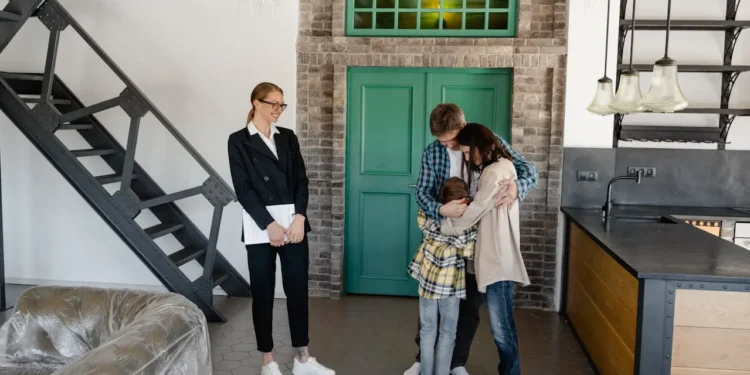Homeownership is increasingly slipping out of reach for millennials, creating a ripple effect that extends far beyond where they hang their hats.
This isn’t just about having a place to call your own – it’s fundamentally reshaping how an entire generation builds wealth, plans for the future, and reaches major life milestones.
The numbers tell a stark story.
In 2024, only 36.4% of Americans under 35 own homes, according to New York Post data.
Meanwhile, affording the median-priced home today requires an income of roughly $126,670 – a staggering 60% jump from 2021 levels, while median income has hovered around $80,610.
This affordability crisis isn’t just delaying homebuying dreams. It’s postponing milestone life events, eroding long-term financial security, and perpetuating generational wealth gaps that could define the economic landscape for decades to come.
But here’s what’s encouraging: while the money problems for millennials are real, they’re not insurmountable. Let’s break down exactly what’s happening and, more importantly, how you can navigate this market successfully.
Why Housing Is Crushing Millennials’ Budgets
The Affordability Gap Has Become a Chasm
Twenty years ago, median home prices averaged 4-5 times median income – a stretch, but manageable for many families.
Today, that ratio has ballooned to 6 times median income, according to Econofact research. It’s not just that homes are expensive; they’re expensive relative to what people actually earn.
Renters aren’t escaping this squeeze either. Rent-to-income ratios have climbed from roughly 25% to 30%, eating up a larger chunk of monthly budgets and making it even harder to save for that elusive down payment.
50% of aspiring millennial homeowners say they simply can’t afford to buy. The Ballard Brief research identifies rising prices (cited by 47-49% of respondents) and down payment hurdles (42-53%) as the primary roadblocks standing between millennials and homeownership.
Supply Shortages Are Making Everything Worse
The math is simple and brutal: the U.S. is short 3.8 million housing units, representing a 52% increase in shortage since 2018. We’re not just experiencing a temporary market hiccup – we’re facing a structural deficit that’s been years in the making.
Zoning restrictions and the “missing middle” housing gap aren’t helping. Many communities lack the mid-density housing options that could provide more affordable alternatives to single-family homes without resorting to high-rise living.
Life Is Happening Later, Making Traditional Timing Obsolete
Millennials are getting married later, starting families later, and hitting traditional financial milestones on a different timeline than previous generations.
These life events typically spur homebuying decisions, but when they’re delayed, so is the natural progression toward homeownership.
Add student loans, high rent payments that prevent saving, and tighter credit requirements, and you’ve got a perfect storm that keeps potential buyers on the sidelines longer than ever before.
How to Buy in Today’s Market: Practical Paths Forward
Think Beyond Traditional Markets and Formats
Geography can be your secret weapon.
Instead of competing in coastal markets where prices have skyrocketed, consider non-coastal cities or suburban areas where your dollars stretch further. Sometimes moving inland by just 30-60 minutes can slash home prices by 30-40%.
7 US Cities Paying People to Move There: Is it Best to Start Over?
Don’t overlook alternative ownership structures either. Shared ownership arrangements, multi-family properties where you live in one unit and rent the others, or co-buying with family members, can make ownership feasible when traditional single-family purchases aren’t.
Here’s encouraging context: millennials already represent nearly 29% of all buyers, with younger millennials (ages 26-34) making up 71% of first-time buyers. You’re not alone in this market – you’re actually driving it.
8 Unique Alternative Housing Options for Today’s Living Conditions
Tap Into Available Support Systems
Before you assume you’re on your own, investigate what help is actually available.
First-time buyer programs, state and local down payment assistance, and tax incentives can significantly reduce your upfront costs. Some current policy proposals even offer up to $25,000 in direct support for qualifying buyers.
The political landscape is responding to this crisis, too. Housing supply initiatives and zoning reform efforts are gaining traction in Congress, which could ease some of these pressures in the coming years.
First Time Home Buyer? Top 5 Tips, 4 Costs to Consider & 4 Questions to Ask First
Get Financially Strategic and Flexible
Start with the fundamentals: improving your credit score, paying down existing debt, and building your down payment fund – even if it’s $50 at a time. Small, consistent progress beats waiting for the perfect financial moment that might never come.
Be willing to adjust your expectations strategically. Smaller square footage, fixer-uppers, or properties slightly outside your ideal neighborhood can be stepping stones to ownership. Remember, you’re buying your first home, not your forever home.
Watch for Market Timing Opportunities
Demographics might work in your favor soon. As baby boomers age out of the housing market and overall demand potentially slows, supply could loosen in the 2030s, according to Business Insider analysis.
Stagnating population growth could further reduce competition for available homes.
This doesn’t mean waiting indefinitely, but it does suggest that improving your financial position now could position you perfectly for better opportunities ahead.
Your Step-by-Step Home Buying Action Plan
Step |
What to Do |
Why It Helps |
|
1. Audit affordability |
Use online affordability calculators to determine realistic home price and monthly budgets |
Sets clear search boundaries and prevents wasted time |
|
2. Explore assistance programs |
Research local/state first-time buyer grants, incentives, and tax breaks |
May significantly lower your upfront costs |
|
3. Get mortgage-ready |
Improve credit score, free up cash flow, get pre-approved |
Maximizes loan options and strengthens your bargaining power |
|
4. Look outside typical zones |
Investigate emerging metros or explore shared ownership models |
Dramatically improves your chances of market entry |
|
5. Monitor timing & trends |
Track demographic shifts and supply changes in your target areas |
Positions you to capitalize on potential affordability improvements |
The Path Forward Starts Today
While housing remains the top money problem for millennials, it’s not an impossible puzzle to solve.
The key is approaching it strategically:
- adapting where and how you buy
- accessing available assistance
- preparing financially for the right opportunity
The market may be tough, but it’s not static. Demographic trends, policy changes, and your own improving financial position can align to create opportunities that don’t exist today
Start today, even if it’s just running affordability numbers or researching assistance programs in your area.
Small progress compounds into real momentum, and every step brings you closer to building equity and achieving homeownership on your own terms.


















